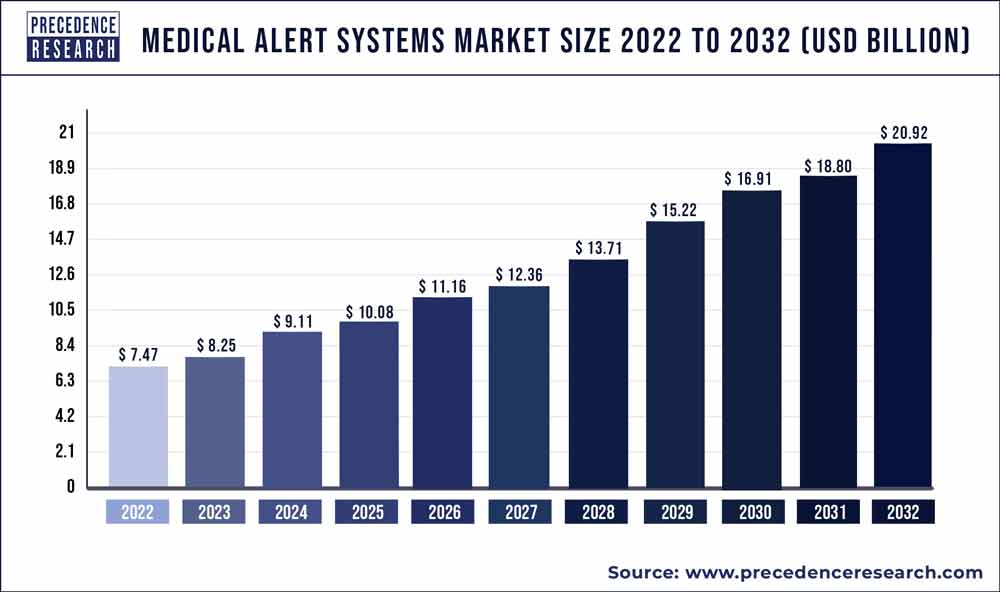The medical alert systems market size was USD 8.25 billion in 2023 and it will hit USD 20.92 billion by 2032, rising at a CAGR of 10.90% by the end of this decade.
Key Takeaways
- North America contributed more than 39% of revenue share in 2022.
- Asia-Pacific is estimated to expand the fastest CAGR between 2023 and 2032.
- By type, the personal emergency response systems (PERS) segment has held the largest market share of 38% in 2022.
- By type, the smart belt segment is anticipated to grow at a remarkable CAGR of 11.5% between 2023 and 2032.
- By technology, the unmonitored medical alert systems segment generated over 35% of revenue share in 2022.
- By technology, the IP-based systems segment is expected to expand at the fastest CAGR over the projected period.
- By application, the home-based users segment generated over 31% of revenue share in 2022.
- By application, the hospitals and clinics segment is expected to expand at the fastest CAGR over the projected period.
The Medical Alert Systems Market is a dynamic industry focused on providing critical support and emergency assistance for individuals facing health concerns, particularly the elderly and those with chronic illnesses. These systems typically include wearable devices or home-based units equipped with communication features to connect users with emergency services or designated contacts in times of need.
Growth Factors:
The market’s growth is propelled by the rising aging population globally, increasing awareness about personal health and safety, and advancements in technology. As people seek ways to maintain independence while ensuring quick response in emergencies, the demand for reliable medical alert systems continues to surge.
Get a Sample: https://www.precedenceresearch.com/sample/3632
Regions:
The market has a widespread presence, with North America leading the way due to a high adoption rate of healthcare technologies. Europe and Asia-Pacific are also witnessing significant growth, driven by increasing healthcare infrastructure and awareness of the importance of timely medical assistance.
Medical Alert Systems Market Scope
| Report Coverage | Details |
| Growth Rate from 2023 to 2032 | CAGR of 10.90% |
| Market Size in 2023 | USD 8.25 Billion |
| Market Size by 2032 | USD 20.92 Billion |
| Largest Market | North America |
| Base Year | 2022 |
| Forecast Period | 2023 to 2032 |
| Segments Covered | By Type, By Technology, and By Application |
| Regions Covered | North America, Europe, Asia-Pacific, Latin America, and Middle East & Africa |
Drivers:
Key drivers for the Medical Alert Systems Market include the growing prevalence of chronic diseases, the need for quick medical response in emergencies, and the integration of smart features in these systems. Technological innovations, such as GPS tracking and fall detection, contribute to the market’s expansion.
Opportunities:
Opportunities abound in the integration of artificial intelligence and IoT technologies to enhance the capabilities of medical alert systems. Additionally, untapped markets in developing regions present avenues for expansion, as awareness about personal healthcare increases and infrastructure improves.
Challenges:
Despite the positive outlook, challenges in the Medical Alert Systems Market include the reluctance of some individuals to adopt new technologies, concerns about data privacy and security, and the need for continuous innovation to stay ahead in a competitive landscape. Overcoming these challenges is crucial for sustained market growth.
Read Also: Pen Needles Market Size to Record US$ 9.48 Billion by 2032
Recent Developments
- In February 2021, Connect America collaborated with Urban Health Plan (US), a US-based health center program, to extend remote patient monitoring (RPM) services to residents in underserved communities across the Bronx, Queens, and Manhattan.
- In October 2020, MobileHelp introduced Micro, a comprehensive mobile medical alert device that combines wearable comfort with a compact and lightweight design while retaining robust technological features. The product includes MobileHelp’s patented automatic fall detection and advanced location tracking technology.
Medical Alert Systems Market Players
- Philips Lifeline
- Medical Guardian
- ADT
- Life Alert
- Bay Alarm Medical
- MobileHelp
- GreatCall (acquired by Best Buy)
- Tunstall Healthcare
- Alert1
- Connect America
- LifeFone
- Rescue Alert
- Guardian Medical Monitoring
- Alert Sentry
- Valued Relationships Inc. (VRI)
Segments Covered in the Report
By Type
- Personal Emergency Response Systems (PERS)
- Nurse Calling Systems (NCS)
- Smart Belt
By Technology
- Two-way Voice Systems
- Unmonitored Medical Alert Systems
- Medical Alert Alarm (Button) System
- IP-based Systems
By Application
- Home-Based Users
- Senior Living Facilities/Senior Care Centers
- Assisted Living Facilities
- Hospitals and Clinics
- Others
By Geography
- North America
- Europe
- Asia-Pacific
- Latin America
- Middle East and Africa
TABLE OF CONTENT
Chapter 1. Introduction
1.1. Research Objective
1.2. Scope of the Study
1.3. Definition
Chapter 2. Research Methodology
2.1. Research Approach
2.2. Data Sources
2.3. Assumptions & Limitations
Chapter 3. Executive Summary
3.1. Market Snapshot
Chapter 4. Market Variables and Scope
4.1. Introduction
4.2. Market Classification and Scope
4.3. Industry Value Chain Analysis
4.3.1. Raw Material Procurement Analysis
4.3.2. Sales and Distribution Channel Analysis
4.3.3. Downstream Buyer Analysis
Chapter 5. COVID 19 Impact on Medical Alert Systems Market
5.1. COVID-19 Landscape: Medical Alert Systems Industry Impact
5.2. COVID 19 – Impact Assessment for the Industry
5.3. COVID 19 Impact: Global Major Government Policy
5.4. Market Trends and Opportunities in the COVID-19 Landscape
Chapter 6. Market Dynamics Analysis and Trends
6.1. Market Dynamics
6.1.1. Market Drivers
6.1.2. Market Restraints
6.1.3. Market Opportunities
6.2. Porter’s Five Forces Analysis
6.2.1. Bargaining power of suppliers
6.2.2. Bargaining power of buyers
6.2.3. Threat of substitute
6.2.4. Threat of new entrants
6.2.5. Degree of competition
Chapter 7. Competitive Landscape
7.1.1. Company Market Share/Positioning Analysis
7.1.2. Key Strategies Adopted by Players
7.1.3. Vendor Landscape
7.1.3.1. List of Suppliers
7.1.3.2. List of Buyers
Chapter 8. Global Medical Alert Systems Market, By Type
8.1. Medical Alert Systems Market Revenue and Volume, by Type, 2023-2032
8.1.1. Personal Emergency Response Systems (PERS)
8.1.1.1. Market Revenue and Forecast (2020-2032)
8.1.2. Nurse Calling Systems (NCS)
8.1.2.1. Market Revenue and Forecast (2020-2032)
8.1.3. Smart Belt
8.1.3.1. Market Revenue and Forecast (2020-2032)
Chapter 9. Global Medical Alert Systems Market, By Technology
9.1. Medical Alert Systems Market Revenue and Volume, by Technology, 2023-2032
9.1.1. Two-way Voice Systems
9.1.1.1. Market Revenue and Forecast (2020-2032)
9.1.2. Unmonitored Medical Alert Systems
9.1.2.1. Market Revenue and Forecast (2020-2032)
9.1.3. Medical Alert Alarm (Button) System
9.1.3.1. Market Revenue and Forecast (2020-2032)
9.1.4. IP-based Systems
9.1.4.1. Market Revenue and Forecast (2020-2032)
Chapter 10. Global Medical Alert Systems Market, By Application
10.1. Medical Alert Systems Market Revenue and Volume, by Application, 2023-2032
10.1.1. Home-Based Users
10.1.1.1. Market Revenue and Forecast (2020-2032)
10.1.2. Senior Living Facilities/Senior Care Centers
10.1.2.1. Market Revenue and Forecast (2020-2032)
10.1.3. Assisted Living Facilities
10.1.3.1. Market Revenue and Forecast (2020-2032)
10.1.4. Hospitals and Clinics
10.1.4.1. Market Revenue and Forecast (2020-2032)
10.1.5. Others
10.1.5.1. Market Revenue and Forecast (2020-2032)
Chapter 11. Global Medical Alert Systems Market, Regional Estimates and Trend Forecast
11.1. North America
11.1.1. Market Revenue and Volume Forecast, by January (2020-2032)
11.1.2. Market Revenue and Volume Forecast, by February (2020-2032)
11.1.3. Market Revenue and Volume Forecast, by March (2020-2032)
11.1.4. U.S.
11.1.4.1. Market Revenue and Volume Forecast, by January (2020-2032)
11.1.4.2. Market Revenue and Volume Forecast, by February (2020-2032)
11.1.4.3. Market Revenue and Volume Forecast, by March (2020-2032)
11.1.5. Rest of North America
11.1.5.1. Market Revenue and Volume Forecast, by January (2020-2032)
11.1.5.2. Market Revenue and Volume Forecast, by February (2020-2032)
11.1.5.3. Market Revenue and Volume Forecast, by March (2020-2032)
11.2. Europe
11.2.1. Market Revenue and Volume Forecast, by January (2020-2032)
11.2.2. Market Revenue and Volume Forecast, by February (2020-2032)
11.2.3. Market Revenue and Volume Forecast, by March (2020-2032)
11.2.4. UK
11.2.4.1. Market Revenue and Volume Forecast, by January (2020-2032)
11.2.4.2. Market Revenue and Volume Forecast, by February (2020-2032)
11.2.4.3. Market Revenue and Volume Forecast, by March (2020-2032)
11.2.5. Germany
11.2.5.1. Market Revenue and Volume Forecast, by January (2020-2032)
11.2.5.2. Market Revenue and Volume Forecast, by February (2020-2032)
11.2.5.3. Market Revenue and Volume Forecast, by March (2020-2032)
11.2.6. France
11.2.6.1. Market Revenue and Volume Forecast, by January (2020-2032)
11.2.6.2. Market Revenue and Volume Forecast, by February (2020-2032)
11.2.6.3. Market Revenue and Volume Forecast, by March (2020-2032)
11.2.7. Rest of Europe
11.2.7.1. Market Revenue and Volume Forecast, by January (2020-2032)
11.2.7.2. Market Revenue and Volume Forecast, by February (2020-2032)
11.2.7.3. Market Revenue and Volume Forecast, by March (2020-2032)
11.3. APAC
11.3.1. Market Revenue and Volume Forecast, by January (2020-2032)
11.3.2. Market Revenue and Volume Forecast, by February (2020-2032)
11.3.3. Market Revenue and Volume Forecast, by March (2020-2032)
11.3.4. India
11.3.4.1. Market Revenue and Volume Forecast, by January (2020-2032)
11.3.4.2. Market Revenue and Volume Forecast, by February (2020-2032)
11.3.4.3. Market Revenue and Volume Forecast, by March (2020-2032)
11.3.5. China
11.3.5.1. Market Revenue and Volume Forecast, by January (2020-2032)
11.3.5.2. Market Revenue and Volume Forecast, by February (2020-2032)
11.3.5.3. Market Revenue and Volume Forecast, by March (2020-2032)
11.3.6. Japan
11.3.6.1. Market Revenue and Volume Forecast, by January (2020-2032)
11.3.6.2. Market Revenue and Volume Forecast, by February (2020-2032)
11.3.6.3. Market Revenue and Volume Forecast, by March (2020-2032)
11.3.7. Rest of APAC
11.3.7.1. Market Revenue and Volume Forecast, by January (2020-2032)
11.3.7.2. Market Revenue and Volume Forecast, by February (2020-2032)
11.3.7.3. Market Revenue and Volume Forecast, by March (2020-2032)
11.4. MEA
11.4.1. Market Revenue and Volume Forecast, by January (2020-2032)
11.4.2. Market Revenue and Volume Forecast, by February (2020-2032)
11.4.3. Market Revenue and Volume Forecast, by March (2020-2032)
11.4.4. GCC
11.4.4.1. Market Revenue and Volume Forecast, by January (2020-2032)
11.4.4.2. Market Revenue and Volume Forecast, by February (2020-2032)
11.4.4.3. Market Revenue and Volume Forecast, by March (2020-2032)
11.4.5. North Africa
11.4.5.1. Market Revenue and Volume Forecast, by January (2020-2032)
11.4.5.2. Market Revenue and Volume Forecast, by February (2020-2032)
11.4.5.3. Market Revenue and Volume Forecast, by March (2020-2032)
11.4.6. South Africa
11.4.6.1. Market Revenue and Volume Forecast, by January (2020-2032)
11.4.6.2. Market Revenue and Volume Forecast, by February (2020-2032)
11.4.6.3. Market Revenue and Volume Forecast, by March (2020-2032)
11.4.7. Rest of MEA
11.4.7.1. Market Revenue and Volume Forecast, by January (2020-2032)
11.4.7.2. Market Revenue and Volume Forecast, by February (2020-2032)
11.4.7.3. Market Revenue and Volume Forecast, by March (2020-2032)
11.5. Latin America
11.5.1. Market Revenue and Volume Forecast, by January (2020-2032)
11.5.2. Market Revenue and Volume Forecast, by February (2020-2032)
11.5.3. Market Revenue and Volume Forecast, by March (2020-2032)
11.5.4. Brazil
11.5.4.1. Market Revenue and Volume Forecast, by January (2020-2032)
11.5.4.2. Market Revenue and Volume Forecast, by February (2020-2032)
11.5.4.3. Market Revenue and Volume Forecast, by March (2020-2032)
11.5.5. Rest of LATAM
11.5.5.1. Market Revenue and Volume Forecast, by January (2020-2032)
11.5.5.2. Market Revenue and Volume Forecast, by February (2020-2032)
11.5.5.3. Market Revenue and Volume Forecast, by March (2020-2032)
Chapter 12. Company Profiles
12.1. Philips Lifeline
12.1.1. Company Overview
12.1.2. Product Offerings
12.1.3. Financial Performance
12.1.4. Recent Initiatives
12.2. Medical Guardian
12.2.1. Company Overview
12.2.2. Product Offerings
12.2.3. Financial Performance
12.2.4. Recent Initiatives
12.3. ADT
12.3.1. Company Overview
12.3.2. Product Offerings
12.3.3. Financial Performance
12.3.4. Recent Initiatives
12.4. Life Alert
12.4.1. Company Overview
12.4.2. Product Offerings
12.4.3. Financial Performance
12.4.4. Recent Initiatives
12.5. Bay Alarm Medical
12.5.1. Company Overview
12.5.2. Product Offerings
12.5.3. Financial Performance
12.5.4. Recent Initiatives
12.6. MobileHelp
12.6.1. Company Overview
12.6.2. Product Offerings
12.6.3. Financial Performance
12.6.4. Recent Initiatives
12.7. GreatCall (acquired by Best Buy)
12.7.1. Company Overview
12.7.2. Product Offerings
12.7.3. Financial Performance
12.7.4. Recent Initiatives
12.8. Tunstall Healthcare
12.8.1. Company Overview
12.8.2. Product Offerings
12.8.3. Financial Performance
12.8.4. Recent Initiatives
12.9. Alert1
12.9.1. Company Overview
12.9.2. Product Offerings
12.9.3. Financial Performance
12.9.4. Recent Initiatives
12.10. Connect America
12.10.1. Company Overview
12.10.2. Product Offerings
12.10.3. Financial Performance
12.10.4. Recent Initiatives
Chapter 13. Research Methodology
13.1. Primary Research
13.2. Secondary Research
13.3. Assumptions
Chapter 14. Appendix
14.1. About Us
14.2. Glossary of Terms
Contact Us:
Mr. Alex
Sales Manager
Call: +1 9197 992 333
Email: sales@precedenceresearch.com
Web: https://www.precedenceresearch.com
Blog: https://www.expresswebwire.com/
Blog: https://www.dailytechbulletin.com/
Blog: https://www.autoindustrybulletin.com/


